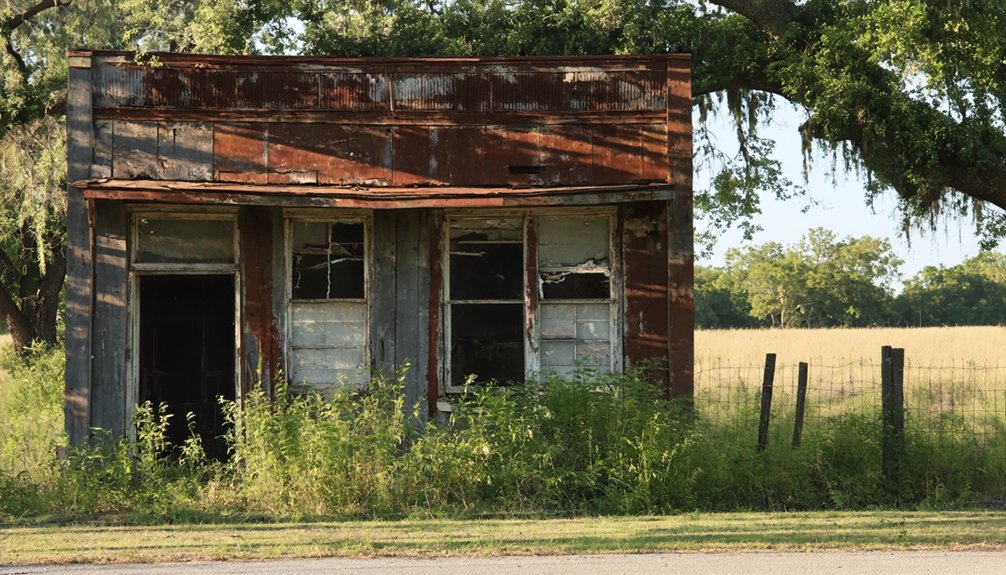You’ll find the ghost town of Utica thirteen miles north of Tyler, Texas, where it once thrived as a bustling trading post in the 1800s. The town served as an essential commerce hub at the intersection of the Dallas-Shreveport road and Tyler trade route, boasting three cotton gins, three flour mills, and a post office by 1892. After the post office closed in 1905, Utica’s population of 100 gradually declined, leaving behind a rich tale of economic transformation in East Texas.
Key Takeaways
- Utica was a prosperous trading post in East Texas that declined after 1905 when its post office closed due to Rural Free Delivery.
- The town featured three cotton gins and three flour mills by 1892, serving a population of approximately 100 residents.
- Located thirteen miles north of Tyler, Utica thrived at the intersection of the Dallas-Shreveport road and Tyler trade route.
- The community’s decline accelerated when residents migrated to larger towns with better economic prospects and railroad access.
- Utica is now among Texas’s 500+ ghost towns, exemplifying how changing transportation and industry patterns affected small farming communities.
The Birth of a Trading Post Town
While trading posts dotted the American frontier in the early 19th century, Utica, Texas emerged as one of many essential commerce centers where settlers and Indigenous peoples conducted trade.
The trading post origins of Utica followed a familiar pattern seen across Texas, establishing itself near important water sources and natural crossroads that attracted both native traders and settlers. Similar to how Charles Strausenback’s store in 1917 marked the beginning of a new trading era, these early posts were entrepreneurial ventures that shaped local commerce. Located at the meeting point of Georges Creek and Brazos River, the site offered an ideal location for trade.
Like other posts of its era, you’d find Utica’s economy built on the exchange of beaver pelts and Indigenous goods for European-manufactured items like firearms and metal tools.
Frontier commerce thrived as Native Americans traded valuable furs and goods for European weapons and tools at bustling trading posts.
These Indigenous interactions shaped the early character of the settlement, as families who operated the trading posts integrated their lives with the business.
The post served as more than just a marketplace – it became a social hub that influenced settlement patterns and eventually laid the foundation for a growing community.
Life at the Crossroads
Located at the convergence of the Dallas-Shreveport road and Tyler trade route, Utica’s position thirteen miles north of Tyler made it a strategic hub for regional commerce in the late 19th century.
As crossroads commerce flourished, you’d have found three flour mills, three cotton gins, a wagonmaker, a druggist, and a lumber manufacturer by 1892.
Community dynamics centered around the post office, established in 1890 with Dayton Balfour as postmaster. The town maintained a stable population of about 100 residents, with diverse craftsmen and traders supporting local agricultural operations. Today, the area where Utica once stood is part of the Tiger Creek Wildlife Refuge. Like many East Texas communities such as Bethel in Anderson, the town’s prosperity gradually faded as residents sought opportunities elsewhere.
Agricultural Heritage and Economic Growth
You’ll find that Utica’s economic foundation in the late 1800s centered on its three cotton gins and three flour mills, which processed the region’s agricultural bounty.
These facilities transformed raw cotton and grain into marketable commodities, providing essential services to local farmers and employment for townspeople. Unlike the practices seen in Thurber where workers were paid with company store scrip, Utica’s mills compensated their employees with regular wages. Like the cotton processing seen in Belle Plain College days, the town relied heavily on agricultural production.
The success of these agricultural processing operations helped maintain Utica’s population around 100 residents throughout the 1890s, though this prosperity wouldn’t last beyond 1904.
Cotton Gins Drive Growth
During the early 1800s, cotton gins transformed Utica and similar Texas towns into thriving agricultural centers. You’d find the first cotton gins arriving from Georgia in 1825, revolutionizing cotton production across the state. These mechanical marvels increased processing from 5 to 50 pounds per day, making cotton farming more profitable than ever. Robert S. Munger’s system revolutionized the entire ginning process with continuous operation and pneumatic suction.
As ginning technology advanced, you could see Utica’s economic pulse strengthen. The local gin became a community hub where you’d meet other farmers, grade cotton samples, and negotiate with buyers. Just as visitors to the oldest operating gin in Burton demonstrate today, these facilities were vital gathering places for agricultural communities.
Operating 18 to 24 hours daily during harvest season, these gins created wealth for operators and farmers alike. By 1860, Texas boasted 2,000 cotton gins, and towns like Utica flourished as essential stops along the expanding railroad network, connecting local growers to broader markets.
Flour Mill Operations Expand
As Texas milling expanded beyond small water-powered operations in the late 1800s, Utica emerged as a notable flour processing center with three mills by 1892.
You’d have witnessed the flour mill innovation taking hold as operations shifted from traditional burr mills to more efficient roller mills, mirroring the transformation happening across Texas.
The milling industry evolution brought significant changes to Utica’s economic landscape, complementing its cotton gins and creating a diversified industrial base.
While larger urban mills like Texas Star and Stanard-Tilton dominated state production with their 125-barrel daily capacity, Utica’s mills served essential local agricultural needs.
You’ll find that this period marked the peak of the town’s prosperity, as railroads and modernization reshaped Texas’s milling sector, eventually leading to the dominance of large corporate operations by mid-century.
Similar to the grist mills of the late 18th century that once dominated early industry, these local operations played a vital role in supporting the region’s agricultural economy.
Following the success of Pioneer Flour Mills in San Antonio, many smaller towns sought to replicate their profitable milling operations.
The Heartbeat of Commerce: Mills and Gins
While many small Texas towns struggled to establish economic footholds in the late 1800s, Utica flourished through its robust milling and ginning operations.
By 1892, you’d find three flour mills and three cotton gins driving the town’s economy, with milling technologies processing local grain and cotton harvests. These operations attracted diverse workers and sparked economic diversification through supporting businesses like wagonmakers, lumber manufacturers, and druggists.
Utica’s mills and gins created a bustling commercial ecosystem, drawing diverse workers and spawning vital support industries across the town.
The Dallas-Shreveport road and trade routes to Tyler enabled the movement of raw materials and finished goods, though the lack of railroad access would later prove problematic.
The mills and gins pushed Utica’s population to around 100 by 1892, but after 1904, the town faced decline as processing activities dwindled and supporting industries disappeared, following patterns similar to other East Texas mill towns.
Postal Service’s Rise and Fall

Beyond the bustling mills and gins, Utica’s growth brought another key development in 1890 – the opening of its post office. As part of Texas’s postal expansion, this federal outpost served Utica’s population of roughly 100 residents, providing essential community connection and access to the wider world.
You’d find the post office functioning as more than just a mail hub. It became a gathering place where you could catch up on news, conduct business, and maintain ties with distant family. The establishment marked Utica’s official recognition and growing civic identity.
But by 1905, the post office closed its doors forever. The introduction of Rural Free Delivery and declining local population spelled the end, signaling Utica’s transformation from a thriving settlement into a ghost town.
The Vanishing Community
Once the post office closed in 1905, Utica’s population of roughly 100 residents began steadily declining as families migrated to larger towns with better prospects.
You’ll find that despite attempts at community resilience, the lack of schools and essential services made it increasingly difficult for families to justify staying. Rural migration accelerated as neighboring towns with railroad access offered better economic opportunities and modern amenities.
Despite local determination, limited services and isolation drove families away as rail-connected towns promised brighter futures and modern conveniences.
The absence of a commercial center or significant industry sealed Utica’s fate.
As agricultural practices modernized across East Texas, reducing the need for rural labor, more residents left to seek viable livelihoods elsewhere.
The pattern you’ll see in Utica mirrors many East Texas ghost towns – when infrastructure and services vanished, the community couldn’t sustain itself, leading to its eventual abandonment.
Historical Significance in Smith County

You’ll find Utica’s key significance in Smith County stems from its role as a regional trading post during the late 1800s, when its post office served as a crucial communication hub for local farmers and merchants.
Through its agricultural development, Utica demonstrated the typical pattern of small farming communities that dotted East Texas during this period, with family farms producing crops that supported the broader Smith County economy.
The town’s evolution from an active trading center to a ghost town mirrors the economic transformation that many similar communities in Smith County experienced as transportation and commerce patterns shifted in the early 20th century.
Regional Trading Hub Legacy
During the mid-19th century, Utica emerged as an essential trading center in Smith County, capitalizing on its strategic location and growing network of trade routes.
You’ll find that trade dynamics initially centered on agricultural products, with cotton and corn moving eastward through challenging river crossings and weather-dependent roadways.
The economic evolution of Utica accelerated as three major developments transformed the region:
- Railroad arrival (1870-1900) opened new markets and shifted farming from subsistence to commercial.
- Timber mills established in the late 1800s diversified the local economy.
- Oil discovery in 1931 brought unprecedented wealth and labor influx.
These changes integrated Utica’s markets with state and national economies, though they also introduced cycles of prosperity and hardship that would ultimately shape the town’s destiny.
Early Agricultural Development Pattern
As Smith County’s agricultural landscape took shape in the 1860s, farmers established a diverse cultivation pattern that would define Utica’s early development.
You’ll find that early settlers embraced crop rotation and sustainable practices, growing corn, sweet potatoes, peas, and beans to maintain soil fertility. They didn’t limit themselves to food crops; the area’s distillery industry flourished, producing significant quantities of corn and rye whiskey.
The construction of brick buildings and lumber mills supported this agricultural expansion, while farmers adapted to economic challenges through innovative solutions.
They made efficient use of the region’s fertile land and water resources, creating a foundation for long-term growth. This agricultural framework would later influence the area’s development through the Civil War period and beyond.
Legacy in East Texas Ghost Towns
While many Texas ghost towns have faded entirely from memory, Utica’s legacy endures as a prime example of the economic shifts that reshaped East Texas in the early 20th century.
The town’s story of economic vulnerability mirrors hundreds of other communities that couldn’t survive the region’s changing landscape.
You’ll find Utica’s cultural memory preserved through:
- Historical records documenting its bustling agricultural processing facilities
- Maps that still mark its location, unlike many forgotten settlements
- Its role in a broader narrative of over 500 Texas ghost towns
Today, Utica serves as a powerful reminder of how communities adapted or disappeared as transportation routes shifted and industries centralized.
You’re witnessing a piece of Texas history that teaches valuable lessons about economic resilience and the transformative power of progress.
Frequently Asked Questions
Are There Any Descendant Families From Utica Still Living in Smith County?
You can’t verify any direct Utica descendants in Smith County today, as historical records don’t confirm family lineages after the town’s 1905 decline and post office closure.
What Natural Disasters or Events Contributed to Utica’s Decline?
While you won’t find records of flood damage, regional droughts during the late 1800s and early 1900s did impact farming viability, though these weren’t the primary cause of the town’s decline.
Did Any Famous Historical Figures Ever Visit or Live in Utica?
Despite having a WiFi-free existence, you won’t find any historical significance tied to famous visitors in this town. Records don’t show any notable people living or stopping by during its brief lifetime.
What Were the Primary Crops Grown by Farmers in Utica?
You’ll find cotton farming dominated the agricultural landscape, supported by three cotton gins. Grain crops like wheat and corn production followed, with flour mills processing the harvest for local needs.
Were There Any Schools or Churches Established in Utica?
While you’d likely be interested in learning about Utica’s schools and churches, there’s no verified historical record of any educational or religious institutions being established in this Texas settlement.
References
- https://www.allacrosstexas.com/texas-ghost-town.php?city=Utica
- https://texashighways.com/travel-news/four-texas-ghost-towns/
- https://en.wikipedia.org/wiki/List_of_ghost_towns_in_Texas
- https://mix931fm.com/12-east-texas-ghost-towns/
- https://www.ghosttowns.com/states/tx/utica.html
- https://kids.kiddle.co/Utica
- https://www.texasescapes.com/TexasGhostTowns/UticaTexas/UticaTexas.htm
- https://www.texasescapes.com/Texas-Ghost-Towns-A-to-Z.htm
- https://www.gardenofthegodstradingpost.com/our-history/
- https://bshc-granbury.org/the-stories/barnards-trading-post/



